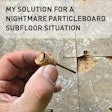Wood shrinks and swells when it loses and gains moisture content (MC). For example, if a piece of 2¼" wide plainsawn red oak flooring were to decrease in MC from 8% to 5%, the net change in MC would be 3%. Using standard values from the Wood Handbook Table 4-3 Shrinkage Values of Domestic Woods, the net change in dimension would be .021" (2.25" x .086 x .03 / .28 = .021"). Expressed as a fraction, .021" would be between 1/64" (.015625") and 1/32" (.03125").
How is this information useful? Let's take a real-world scenario and show how a quantitative understanding of dimensional change helps us perform an analysis.
SCENARIO: We look at a wood floor that we installed last year where the customer has called to complain about gaps between boards. As part of our normal procedure, we look at the surface of the floor to see if individual boards are flat, cupped (concave), or crowned (convex). In this case, the boards are still very flat. Then we determine the size, frequency and distribution of the gaps. We note the minimum and maximum gaps, then we eliminate the smallest and largest gaps to describe the range, which characterizes the majority of the gaps (80-90%). In statistics this is referred as "eliminating the outliers." Now we choose several locations where the gapping is the most severe and begin a series of accurate board-width measurements, along with MC of the individual boards. Our results are:
MC of all of the boards is less than 6%. We estimate the MC at 5% based on interior RH for the last three weeks using Wood Handbook Table 4-2 Moisture Content of Wood in Equilibrium With Stated Temperature and Relative Humidity. The widths of individual boards range from 1/64" to 1/32" less than the manufactured width of 2¼". The gaps are located between every board and range in size from 1/64" to 1/32".
Danger!
FORMULA ALERT: IF YOU BECOME SHORT OF BREATH, BREAK OUT IN A COLD SWEAT, AND HAVE DILATED PUPILS WHEN YOU READ FORMULAS, please skip this section of the blog. For you brave souls, let's proceed.
FIRST FORMULA (Change in Dimension)Δ D (change in dimension) = Manufactured Width x St (Shrinkage factor from Wood Handbook) x Δ MC / .28
SECOND FORMULA (Change in Moisture Content)Δ MC = [Δ D x .28] / [ Width x St ]
With these two formulas we can:
1 - Predict the amount that a board will swell or shrink (Δ D) and2 - Estimate the magnitude of change in MC (Δ MC) based on the current width of the board.
IT'S SAFE TO START READING AGAIN. Danger over.
Now it's time for some SHRINKAGE RULES:
Rule Numero Uno: If a board is less than its manufactured width, it has lost MC since it was manufactured.
Rule Numero Dos: If a board is exactly its manufactured width, it is at the same MC as at the time of manufacture.
Rule Numero Tres: If a board is greater than its manufactured width, it has gained MC since it was manufactured.
Applying Rule Numero Uno, we know that our boards that are smaller than the manufactured width have lost MC. Using the SECOND FORMULA for Δ MC, we can pretty accurately quantify the change in MC.
For boards that are 1/64" narrower than 2¼", the Δ MC is 2.26%:
Δ MC= [Δ D x .28 ] / [ Width x St ]Δ MC= [ 1/64" x .28 ] / [ 2.25" x .086 ]Δ MC= [ .015625" x .28 ] / [ 2.25" x .086 ]Δ MC= [ .004375 ] / [ .1935 ]Δ MC= .0226 = 2.26%
For boards that are 1/32" narrower than 2¼", the MC is 4.52%:
Δ MC= [Δ D x .28 ] / [ Width x St ]Δ MC= [ 1/32" x .28 ] / [ 2.25" x .086 ]Δ MC= [ .03125" x .28 ] / [ 2.25" x .086 ]Δ MC= [ .00875 ] / [ .1935 ]Δ MC= .0452 = 4.52%
If we add the Δ MC to our current 5%, the boards that are 1/64" narrow were originally at 7.26% (5% + 2.26% = 7.26%). The boards that are 1/32" narrow were originally at 9.42% (5% + 4.52% = 9.53%). This allows us to estimate MC at time of manufacture between 7.26% and 9.52%.
I find these quantitative methods to be useful tools when working through the analysis of a wood floor that has evidence of a change (or changes) in MC. In new construction there are frequently several MC changes, starting with the adsorption of excessive moisture from the subfloor, then the eventual drying during the following winter heating season.
Let's explore how doing all this rigmarole calculating helps with analysis. Let's change our scenario by a single factor: instead of gaps that range from 1/64" to 1/32", how about gaps that range from 1/32" to 3/64" with individual board shrinkage that ranges from 1/64" to 1/32"? We have already done the calculations on the board shrinkage, but that doesn't account for the additional size of the gaps. SO… something besides seasonal low interior RH would have to be the cause of the increased size of the gaps. Maybe the flooring was left on the job to "acclimate" and picked up some excessive moisture before it was it was installed? Or…
































